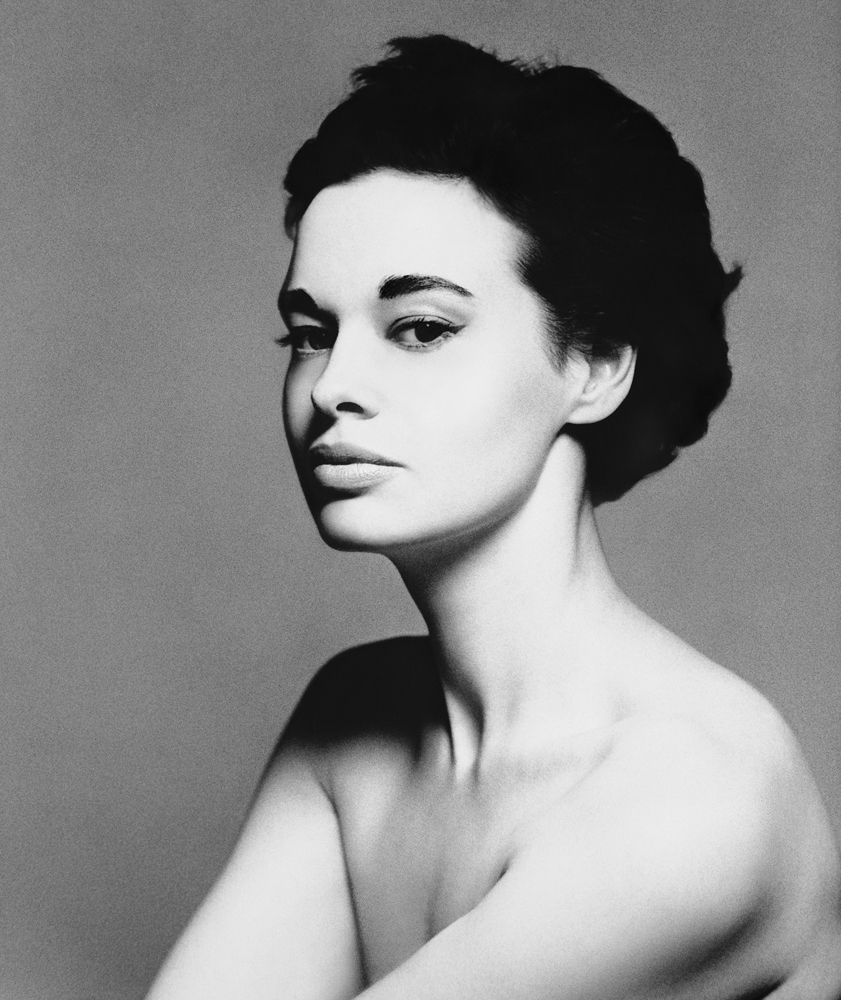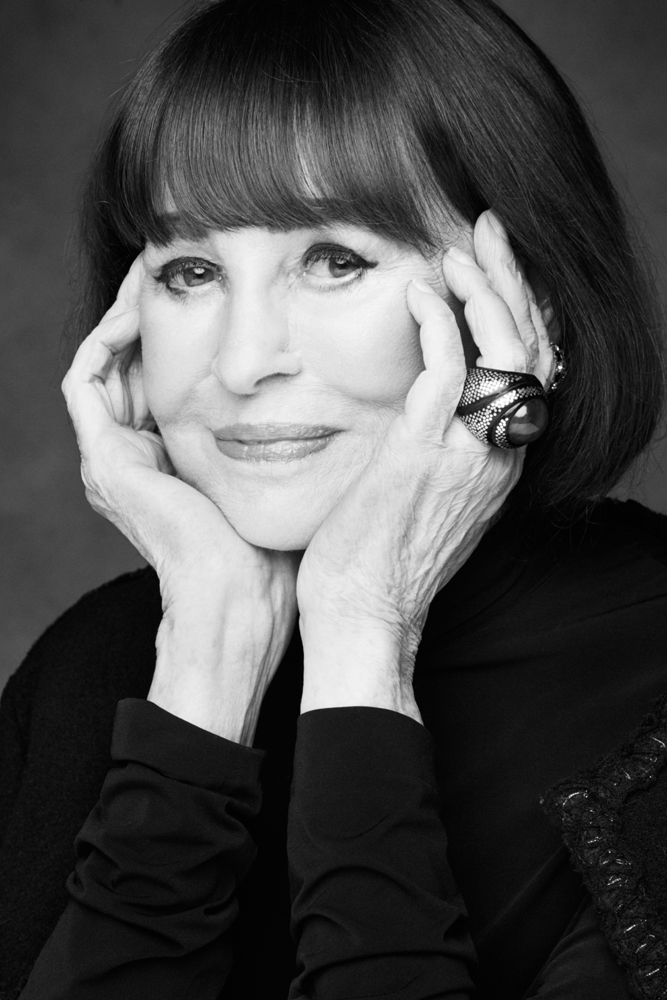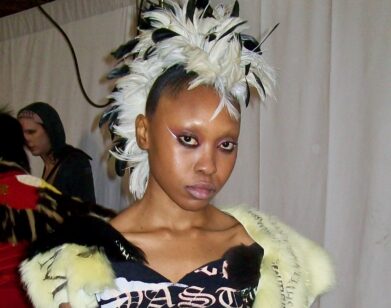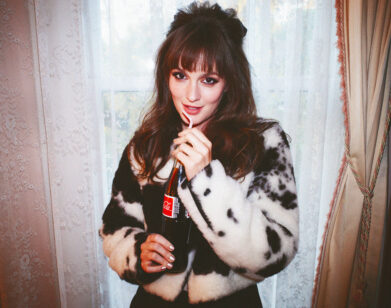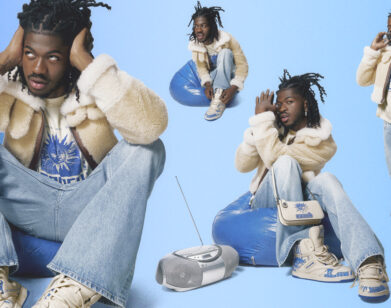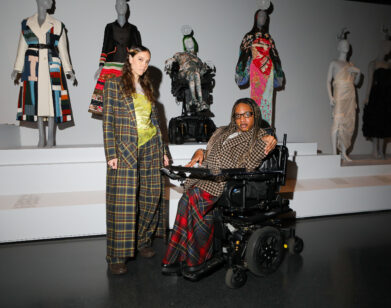Remembering Gloria Vanderbilt
Gloria Vanderbilt has lived 90 years in the eye of the public—and in the camera’s lens—all the while exhibiting a signature grace and courage that has turned her name into a synonym for American style. The photographic record of her life amounts to a public performance, a kind of silent-movie role, played across time. In concert with hundreds of photographers, Gloria has given image to perseverance, enigmatic glamour, and a unique visual vocabulary of color and pattern. It was through these engrossing images that I first came to know of her remarkable life.
Born in New York City in 1924, her first name comes from her elegant young mother, Gloria, and her last name from her railway-heir father, Reginald Vanderbilt, who died while she was a baby. Her inherited privilege, and the loss of its paternal source before she could know him, characterizes the wide pendulum swing that has metered her experience. Her father’s early death and the subsequent, highly publicized custody battle for Gloria seemed to forecast a life with many more plot twists to come—both private and professional—over the decades. Throughout, she has remained a visual symbol of resilience. Her son, the CNN anchor Anderson Cooper: “My mom is a survivor, but has none of the toughness that term often implies. She has strength, great stores of it, but she has refused to develop a layer of thick skin to protect herself.”
Gloria and I met as a result of the film portrait/homage I made about her, Precious Mettle, which is part of my 2013 video installation In the Air, recently presented at the Whitney Museum in New York. In conversations with her, I’ve learned that she begins most days by returning to her art studio, located a floor below her apartment on the east side of Manhattan to work on her accomplished and heartfelt paintings and drawings. This past June an exhibition of her artwork opened in Toronto. (The local press swooned over her opening night appearance in “a 1970 silver lamé kimono by Halston, metallic platform heels, and her signature bobbed hair.”) I know from happy experience that her evenings can run to the wee hours, as she remains a legendary hostess, offering her guests delicious meals and lively conversation within her apartment’s embellished pink lacquered walls.
It has been my great privilege to discover the impressions I first had—from traces of Gloria I found in the world—are true. She has the rare ability to default to optimism. She is grateful for a rich and fulfilling history but is most interested in the new day ahead. She has been a lifelong champion of beauty and will leave this world a lovelier place for all she has contributed to its culture. And, like a monarch butterfly, Gloria demonstrates that adversity can be met and superseded by the most delicate of spirits, brightly colored, yet sure on its course.
I spoke with Gloria this past May when she visited me in my downtown studio. A camera crew filmed us for an upcoming HBO documentary about her life, while we spoke about the past, the present, and of course, with Gloria, the future.
———
T.J. WILCOX: Your cat appeared briefly at the dinner party you gave the other night.
GLORIA VANDERBILT: Cats are so interesting—endlessly fascinating. I got one and then I got her brother a week later. When I brought him home, she had a nervous breakdown. She went under the sofa.
WILCOX: But she’s fond of you, isn’t she?
VANDERBILT: She’s absolutely devoted to me. She follows me around. It’s unconditional love.
WILCOX: It’s complicated to do an interview with you because you’re such a big subject. It might seem like I’m leaving out big pieces of your life, but I’m going to have to leave some things out because they’d have to give us the whole magazine in order to get everything in. But let’s start with the fact that HBO is making a documentary about you. And just the other day you had an interview with your son, Anderson Cooper. You told me that the first question he asked you was, “Why are you doing this?”
VANDERBILT: Yes! And I said right away, “Because I’m a ham.” I always like to answer spontaneously. But then I thought about it, because I’m really not a ham, at least I don’t consider myself one. What I really wanted to say to him was, “I’m doing it because I see you so rarely, because you’re so busy. I get to spend some time with you.” [laughs]
WILCOX: That makes sense. Your son is traveling the world. But what does the documentary mean for you? Why are you doing it now?
VANDERBILT: I don’t know. I just sort of wanted to do it. I’m 90 years old, and if I’m not going to do it now, when am I going to do it, you know?
WILCOX: Good attitude, right answer!
VANDERBILT: I also feel that I’ve resolved so many things in my life. I like the idea of showing that you can go through a lot and still be on your feet, still be working, and still be positive about life. And that you can still think that the best thing is around the corner, which I really do. I think something wonderful is going to happen to me. Maybe tomorrow. The phone can ring and your whole life can change. There’s a saying I read recently; I painted it on the fireplace and in my studio: “Be kind to everyone you meet, for everyone is fighting a great battle.” We all are. Everyone.
WILCOX: I thought that we might go back to the beginning, a little bit. The first line in the film I made about you, Precious Mettle, is, “When she was born in 1924, Gloria Vanderbilt’s first cry was the last gasp of New York’s 19th-century tycoon aristocracy.” You were born into a culture and society that was being eclipsed—times were really changing, it was the modern world. Do you remember much about those years?
VANDERBILT: I was 18 months old when my father died. My mother, who was 19, went to live in Europe, where she grew up. She went to Paris, and this was 1925 or 1926, which was the time for Paris. Can you imagine how extraordinary it was to be so beautiful and have a lot of money and go there and suddenly be rid of old, stuffy Newport? I went with her, and so my family was my Grandmother Morgan and my nurse, who I called Dodo. I really didn’t see much of my mother because she was out having a good time. And I think we only visited the rest of the family once.
WILCOX: Your mother was so gorgeous.
VANDERBILT: Oh, beautiful. And so was her twin sister, my aunt Thelma. They were identical twins. I could walk into a room and I couldn’t tell which one’s which.
WILCOX: And they were very close, weren’t they?
VANDERBILT: They were. One would start a sentence and the other would end it.
WILCOX: I know that after you came back to the United States, you went to Long Island and then Newport. I guess you were visiting your paternal grandparents?
VANDERBILT: I first came to America at the age of 8. When we visited the family, I remember my grandmother had something like Alzheimer’s. I was living with my cousin Bill Vanderbilt and his family. I remember going to the Breakers, where my aunts Gertrude and Gladys were—they were sitting in the living room and my grandmother came down the stairs. She was tiny, like five foot two, and her dress absolutely beautiful, pearls and everything. I was with my cousin Emily Vanderbilt, and she looked at us and said, “Who are these children?” She just didn’t know. Then she sort of sat in a chair away from everyone, really out of it. So we really never knew each other.
WILCOX: Did that world—life at the Breakers—seem like another era?
VANDERBILT: No, it absolutely didn’t. It’s like if you’re living in a jungle—it’s just the way that people live. My mother had a beautiful house in Paris, but it wasn’t the Breakers. It all seemed sort of like a fairy tale.
WILCOX: Your world is very small as a child. Everyone’s world is small as a child.
VANDERBILT: That’s the way it is.
WILCOX: There’s a photo of you that comes to my mind, the photo taken of you with Dodo, your beloved nurse, in 1925.
VANDERBILT: That was taken the day my father died, because I was taken from Oakland Farm, where my mother and father lived in Newport. I was taken to the Breakers because they didn’t think I should be around when the funeral was going on.
WILCOX: It’s a very poignant photograph. It shows the trappings of great wealth. And yet, here you are, this tiny little creature, alone, as I understand you often were at that age, except for your nurse. Was it lonely for you?
VANDERBILT: Well, it didn’t seem so if you don’t know anything else. I was really happy.
WILCOX: You were happy with Dodo?
VANDERBILT: She was like my mother. She was terrific and warm. She was Irish.
WILCOX: There are very elegant pictures of you standing alongside your mother, and then there are these sweet photos of you grabbing hold of Dodo, holding her with a great big bear hug. You sense the difference between those two relationships.
VANDERBILT: Absolutely. I really never knew my mother. I never bonded with her, unfortunately.
WILCOX: She was so young, and she seems to have been a bit maybe fearful of you from the beginning.
VANDERBILT: She said she was always afraid to pick me up when I was a baby, because she was afraid I might break. But she was so young. Think of it: to be so young and beautiful and have all that money and glamour and everything.
WILCOX: There are lots of pictures of you aboard ocean liners in the 1920s. And there are pictures that document your mother’s glamorous life.
VANDERBILT: She was beautifully dressed going out. My Grandmother Morgan was living in the house in Paris, and she’d draw a bath for her. And she had a lady’s maid who would dress her. She would sit at the dressing table, and the maid would pull up her stockings and attach them to her garters. The maid knew how to marcel her hair—she could do anything. She always filled my mother’s purse when she went out, put everything in it, and took everything out of it when she came back. She dressed and undressed her, so to speak. But that’s the way it was done in those days. I wanted to be close to her, but it was just a completely different time. It wasn’t unusual for someone in that situation to be that way. They didn’t see their children the way people do now.
WILCOX: There’s a photo of you at maybe 5 or 6, and you’re in a garden in England—
VANDERBILT: That was at Burrough Court in Melton Mowbray. My aunt Thelma married Marmaduke Furness, Viscount Furness, who owned the shipping lines, and they had a beautiful house. In those days all the married women had affairs, and no one thought anything of it. It was part of the culture. It’s a famous story—my aunt had an affair with the Prince of Wales, and then she was going to New York to be with my mother. She told her close friend, Wallis Simpson, “Take care of the little man for me while I’m away”—and that’s how they got together!
WILCOX: So much for best friends.
VANDERBILT: But my aunt told me later that she never, ever thought of marrying him. It was an affair-a kind of glamorous affair.
WILCOX: I’m sure she wouldn’t have wanted to bring down the monarchy.
VANDERBILT: That never occurred to her.
WILCOX: You lived a very nomadic life in your youth—you describe it as a “caravan.” Was there anything positive about that, which you brought into your adult life?
VANDERBILT: A home is very, very important to me. But I do change things around a lot. I like to repaint rooms, to redecorate. I mean, my dream would be to have pieds-à-terre in various places.
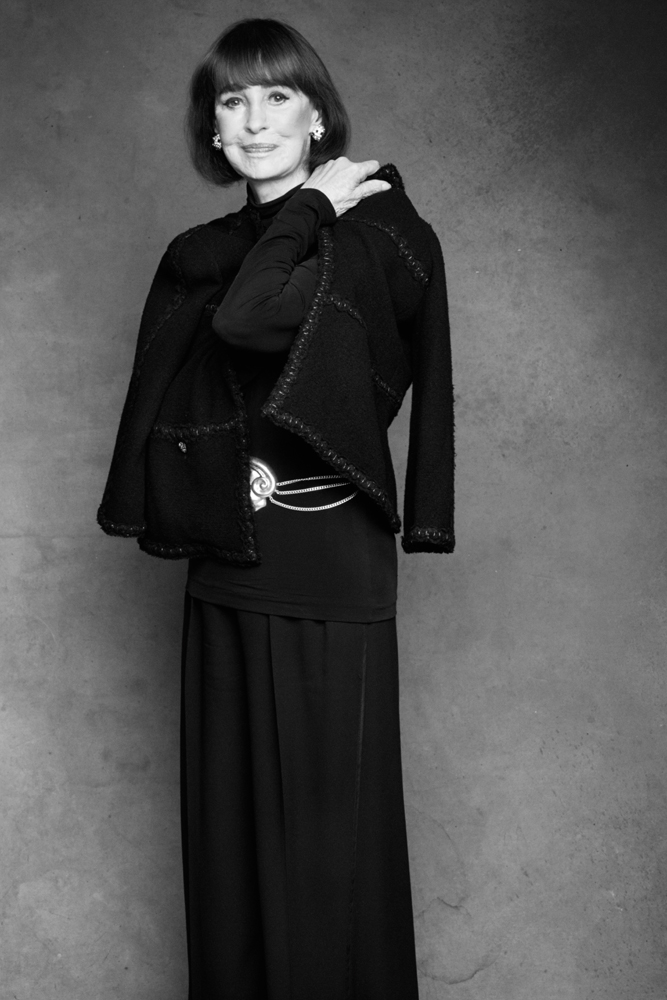
WILCOX: By the early 1930s, your Vanderbilt relatives were getting very nervous about this life you were leading.
VANDERBILT: I had a legal guardian, so he was the one, really, who made all the decisions. My Grandmother Morgan was agitating to the legal guardian, who was then contacting Aunt Gertrude, who was my father’s sister, and she was starting the work on the custody case. So then they said I had never gone to school before. When I was 8, it was time to think about school. The guardian said, “Well, she should be brought up in America.” My mother was planning to take a house on 72nd Street, and I was going to go to Spence, I think it was. I went for the summer to stay with Uncle Bill and Mummy Anne, and that was the first time I really knew I was connected to a family.
WILCOX: We have to say something about the incredible custody trial that you endured in those days. It was your father’s sister and your grandmother, your mother’s mother, combining forces against your mother. And you were put through a spectacular custody trial that was such a huge news event. And that must have been so over-the-top for a young child.
VANDERBILT: The worst thing about it was that I didn’t have anybody to communicate with. My aunt never talked to me about it. We communicated through these impossible lawyers.
WILCOX: It’s very painful to look at the images of you having to shove your way through crowds to the courtroom in those days. I wonder if people thought that because you inherited wealth, you were somehow more resilient than other children.
VANDERBILT: I didn’t even think of wealth, because all the people I was around had it. But that experience was scary. It took me a long time to overcome that, which I finally did. It was difficult and horrible.
WILCOX: You lived for a time with your aunt at Old Westbury, on Long Island.
VANDERBILT: Yes, and she still had that big house on Fifth Avenue.
WILCOX: She was a sculptor and the founder of the Whitney Museum. Were you aware as a child of her art practice? And were you making art yourself at this point?
VANDERBILT: Well, everybody in school makes art. But she had a beautiful studio on her estate in Old Westbury where her other children also lived. But none of them lived close together because their houses were separated by a forest. So it wasn’t like you were next door to each other. I remember my cousin and I would go sneak around her studio and all her statues were covered with huge drop cloths. She wasn’t working on them. She had started to write. I lived in her house in Old Westbury, and I had to visit my mother on the weekends.
WILCOX: She gave you a small room to decorate, didn’t she? And you’ve done a lot of interior decoration in your life. Has that kind of practice informed your drawings and paintings?
VANDERBILT: Oh, absolutely.
WILCOX: In a way, you were an early installation artist because you were so involved with the construction of your interiors as complete artistic environments.
VANDERBILT: I love to do that. I mean, I love to decorate and redecorate. Now it’s called interior design, but the term decorating is fine with me.
WILCOX: I think you’re an installation artist and not a decorator. But what was this first room? Do you remember what you did?
VANDERBILT: That was my Egyptian room. It had a brass tray that was inlaid. I made Turkish coffee.
WILCOX: Very exotic.
VANDERBILT: And then I had friends up to serve it. I had a few pillows covered in Egyptian fabric. [laughs]
WILCOX: I’m sure your friends were very impressed. Not long after this, you caught the eye of Diana Vreeland. And she wanted to photograph you for Harper’s Bazaar. It was around 1939.
VANDERBILT: I remember when she came out to lunch to Aunt Gertrude’s. And Larry Lowman, who was married to my sister Cathleen [Reginald Vanderbilt’s daughter from a previous marriage]. I was coming from New York and we were all driving out together, and Larry said to me, “Tell Diana how you’re decorating your room.” I said that it was Egyptian, and of course she loved that. She sent Louise Dahl-Wolfe to photograph me—that was the first time I was photographed. I was 15.
WILCOX: And how did you feel about that?
VANDERBILT: It was heaven. [Wilcox laughs] Because I was trying to find my identity, to find who I was. We all are at that age. It was so wonderful because Louise Dahl-Wolfe put pancake makeup on me, and I just opened up in a whole other way. I thought, “Oh, yes, this is what I want.”
WILCOX: You took to it like a fish to water, and the proof is in the photos. No one would think it’s your first photo session.
VANDERBILT: Well, I really loved it and continued to love it.
WILCOX: That was the beginning of your being photographed. You have been the subject of so many photographers: Avedon, Cecil Beaton, Gordon Parks, George Hurrell, Lillian Bassman, George Hoyningen-Huene, Horst, Scavullo, Annie Leibovitz—that’s just the tip of the iceberg. It seems almost like a dance that you’ve had with all of these photographers over the years.
VANDERBILT: I really liked working with them all, some more than others.
WILCOX: Avedon played a very particular role.
I’ll always remain friends with men I’ve been in love with. Each one gave me so much, in so many ways. Gloria Vanderbilt
VANDERBILT: Avedon was so important to me in my life. Not only as a friend, but what he gave me, what he did for me. I was kind of trying to get it all together, and he was one of the people to help me do it.
WILCOX: Do you think you learned something about yourself?
VANDERBILT: Oh, absolutely, every time.
WILCOX: Do you think it was a kind of acting? You hadn’t really started acting in those first photographs.
VANDERBILT: When I was photographed, I didn’t feel I was acting. I just felt I was being photographed. It sort of taught me things about myself that I didn’t know and was trying to find out.
WILCOX: Not long after that first photo session, your mother was living in Los Angeles, where you went for a summer vacation. It sounds like you had a ball that first time in Hollywood. Did you consider becoming an actress when you were there?
VANDERBILT: I would have died to. Don’t think I didn’t think about it. That’s how I met Howard Hughes, really, because he called my mother and said he wanted to meet her and talk to her about something. She thought he was coming to court her.
WILCOX: Oh, boy.
VANDERBILT: Well, they were the same age. [Wilcox laughs] Then he said he wanted to do a screen test of me, and that’s how I met him. The screen test never materialized. We just became lovers. It was much better, really.
WILCOX: Did he ever take you up in his plane?
VANDERBILT: Oh, we used to go up in his plane all the time and fly to Santa Barbara or Canada. We were very much alike in a lot of ways.
WILCOX: Can you say something more about that?
VANDERBILT: He was very shy, so was I. He had lost his parents when he was very young, and I really had too. I mean, nobody should get married at 17, but I made a terrible mistake.
WILCOX: Well, you recovered. Before we get you married off, I want to hear a little bit about being so young and getting ready to go out for a night on the town in Hollywood.
VANDERBILT: First of all, when I went out there, it was like I was going to the Land of Oz. It was so exciting. I was wearing a big hat on the plane. It took nine hours then to fly out there. I thought my mother was going to meet me, but she didn’t. But then on the other hand, Aunt Gertrude didn’t take me to the airport to say goodbye [laughs], so fair enough. My mother was not in good shape at all that summer, so I didn’t see much of her. But I flew out with a chaperone named Constance. I had been very sheltered before that trip. I was madly in love with a young man who was in his senior year at Princeton when I went out there. I fully intended to go there for two weeks and come back and go up to the Adirondacks, which we usually did in the summer. Anyway, Constance lasted a week, and my mother sent her back to Aunt Gertrude, and I started going out with movie actors. I became engaged immediately to Van Heflin, who was an actor then. We even went looking at houses together that we were going to live in. And then I met Pat di Cicco [a Hollywood agent]. He could be in a room full of people and have everybody laughing. He was just funny. He was also scary. And I was very scared of him when I married him.
WILCOX: He was a handsome devil. He looked like a movie star himself.
VANDERBILT: He looked actually very much like Dean Martin. No one could beat Pat di Cicco with a group of people making gags and talking. He was a big gambler. That’s the way he made his money.
WILCOX: So what was it about this guy? I’m trying to latch on to why you married him.
VANDERBILT: He was funny. He was so sure of himself, and I was so unsure of myself. He really treated me terribly. When I left him, I really thought he was going to kill me.
WILCOX: Was he physically abusive?
VANDERBILT: Yes, yes. It’s interesting because years later when Wyatt [Cooper, Vanderbilt’s fourth husband] and I were in Southampton, he was staying at Morton Downey’s over the weekend. Morton said, “Can I bring him over for lunch?” So we said, “Sure.” Wyatt was so fascinated. He said if he had met him not knowing anything that I had said about him, he would have thought that he was a great couturier, like Balenciaga or something. He was still, of course, very good looking. So I saw him after all those years. I wasn’t scared of him anymore.
WILCOX: Glad to hear it. Speaking of clothes, I think this was the period in your life when you describe wearing something you called “tabletop dresses”—dresses that were of particular interest from the waist up.
VANDERBILT: Yes, those were by Howard Greer, who designed a lot of Rita Hayworth’s clothes. When Pat and I used to date, we’d go out to nightclubs with Rita, who was then married to Eddie Judson, and she was wearing Howard Greer’s clothes. Howard Greer called them tabletop dresses because women then were photographed in nightclubs sitting at tables, so it was from the table up that the dress was designed to be very glamorous.
WILCOX: That’s one more example of photography entering into people’s lives. These outfits were literally created for the camera and the situation in which they were going to be worn.
VANDERBILT: Absolutely. And Rita, who just looked so gorgeous, never said one word. She would sit there and say nothing. Eddie Judson kind of was her manager and he took over. Since then, I’ve become friends with Yasmin [Aga Khan], Rita’s daughter.
WILCOX: You’ve worn beautiful clothes all of your life. It seems as if you’ve always loved getting dressed up. I know you’ve collected Fortuny gowns over the years. And you’ve worn Charles James.
VANDERBILT: I wore one of James’s dresses and I knew him, you know. The dress was actually made for Millicent Hearst, Mrs. William Randolph Hearst, but it fit me perfectly, and I wore it as the chairperson of a benefit for cerebral palsy in 1952. I wore the dress for just the night and then I gave it back. He was such a perfectionist. He was making a suit for me, and he wanted fitting after fitting after fitting, and I’d go there and it was never finished. I was recently looking on [the online design and antiques marketplace] 1stdibs, and it has a wonderful vintage collection of clothes. There’s one suit that’s not signed but they say it’s Charles James, and I often wonder if that’s the suit that he never finished.
WILCOX: Let’s move ahead a little bit now. You had two early marriages, one of which very happily resulted in two sons with the conductor Leopold Stokowski. The marriage ran its course, and you returned to New York City in 1954. It seems, at that moment, you entered the world in a more independent way—that returning to New York was a very important transitional time for you.
VANDERBILT: Yes.
WILCOX: During the ’50s, you wrote the first of many books, you had your first art exhibition, and you began acting. It was a very busy, productive time. You’ve also described that Frank Sinatra played an important role in that emerging independence at that time of your life.
VANDERBILT: I really thought Stokowski was God. He was obviously a father figure to me because of the difference in our ages. But we were married for a decade and we lived a very secluded life. We had few friends. He wanted just me. He had told me that he was related to the Habsburgs and invented that he had had a nanny who he adored and had brought him up and so forth. Then we went to London one time when he was conducting, and he said, “There’s somebody I want you to meet; she’s in a nursing home.” We went there on the train and I realized it was his mother, who was still alive. I felt then that he was a fake, and it completely destroyed me. I felt he hadn’t trusted me. He still said that the person we were going to visit was his old nanny. But I knew it was his mother. And that’s when I knew I was going to break away. But he said, “I’ll never give you a divorce. I’ll never let you go.”
WILCOX: These men in your life, my gosh…
VANDERBILT: I was not strong then, really. But I was determined. [laughs]
WILCOX: So you met Sinatra?
VANDERBILT: [Her friend, the songwriter] Jule Styne called me and said, “Sinatra’s in town and he’d like to meet you.” Leopold was then on tour all the time, and I was starting to go out. So we met and he changed my life. He really did. In so many ways. I mean, I’m eternally grateful to him.
WILCOX: Did he encourage your acting?
VANDERBILT: Oh, yes. He put me on a contract for Ocean’s 11 [1960] and two other movies. And I went out and saw him continuously for three weeks when he was performing at the Copacabana in New York—every night, every day. Then he went to Australia on tour, and that’s when I met Sidney Lumet and got very involved with him. When I went out to do the movie for Frank, he didn’t meet me at the plane, which I thought he should have. The movie was called Johnny Concho [1956], and I hadn’t really read the script. I was going to Sandy Meisner’s acting class and was very serious about it, and so I thought, “The heck with it, I’m not going to do this film. I’m going to go back to New York and to Sidney, who’s waiting there for me.” And that’s what I did.
WILCOX: You mean, you just turned around and got back on the plane?
VANDERBILT: No. I was there about a week. Sinatra was in Palm Springs; we talked on the phone. But I kept thinking of Sidney and Sandy Meisner’s acting class, and I wanted to be a real actress. I hated the script of Johnny Concho, and so a week later, I went back. But Sinatra and I remained friends.
WILCOX: Did you?
VANDERBILT: Always, forever. I’ll always remain friends with men I’ve been in love with. Each one gave me so much, in so many ways—except di Cicco, who I have really nothing but terrible things to say about.
WILCOX: Was Sinatra a good boyfriend?
VANDERBILT: Oh, yes, he was so romantic. I never, ever saw sides of him that I’ve heard about.
WILCOX: The cruel, harsh sides?
VANDERBILT: Never, ever. Oh my God, he couldn’t have been. It was like Prince Charming had come into my life. And it was really difficult. I took my children out of the apartment where I was living with Stokowski and went to a motel. I was fearless. Wild horses couldn’t stop me.
WILCOX: That must have been exciting.
VANDERBILT: Yeah, it really was. And he talked a lot about his life and his relationship with the whole Mafia thing.
WILCOX: Another man who was an important part of your life in those New York days was Truman Capote.
VANDERBILT: Oh, yes, Truman. Well, he wanted to control everybody’s life.
WILCOX: [laughs] Where did you two meet?
VANDERBILT: He was a great friend of Carol Marcus [actress and socialite who married Walter Matthau]. That’s how I met him. But he really did want to take over people’s lives. And he certainly did try.
WILCOX: Some have said that his famous character Holly Golightly in Breakfast at Tiffany’s was a tribute to and a portrait of you and your friend Carol.
VANDERBILT: I think it’s a combination of both. I had a studio then, which was very much like the house that he wrote about Holly Golightly living in. And also I had a great childhood friend called Russell Hurd, who was actually living in my studio at one point, and I think Truman got the idea of the main character from Russell. Truman used to come to the studio a lot and talk to Russell and so forth. So I think that’s where the whole idea came from.
WILCOX: He proved to be a very complicated and maybe disingenuous friend. But he must have been good fun.
VANDERBILT: He was terrific, but you never trusted him. I would never have revealed anything to him that I didn’t want repeated because he was a terrible gossip about everyone. Well, finally, at the end of his life he was not the same person as he was in those days.
WILCOX: This might be a funny segue, but Capote was a frequent guest later in life of Johnny Carson’s. He was a very great friend of Carson’s wife. Johnny Carson played a very important role in your professional life as well. How did you come to know him? Did he seek you out because he knew your art?
VANDERBILT: I went on Johnny Carson when I started designing fabrics.
WILCOX: But it was a body of artwork, the collage paintings you showed at the Hammer Gallery in 1969, that caught the attention of the manufacturers in the first place?
VANDERBILT: Yeah, absolutely. Those paintings were very decorative. They lent themselves to fabric design, and that’s how I started in home furnishings.
WILCOX: So it began in decorative fabrics and then expanded.
VANDERBILT: Yes, then I went into designing china and glassware and sheets and all things that were connected to the home. And then I started touring for the stores—I think I was one of the first designers to do that. I would introduce the collections in stores all over the country. It was very successful.
WILCOX: When did the jeans come in?
VANDERBILT: I had my own business of designing clothes on Seventh Avenue, which I opened with Ben Shaw, the dean of Seventh Avenue. We folded after two years because there were problems, although I never knew what they were. But by then, I was contracted to design blouses for a blouse company, and there was a kind of merchandising genius called Warren Hirsh, who had an idea for me to do jeans. That’s how that started. And that was very successful. I did a lot of promotion, commercials …
WILCOX: They say you’re the first person who produced what we call “designer jeans.”
VANDERBILT: Yes, I think that’s true.
WILCOX: That’s something of a revolution.
VANDERBILT: I mean, what can you do?
WILCOX: [laughs] Well, you can do a lot if you’re Gloria Vanderbilt.
VANDERBILT: They’re just jeans after all, really.
WILCOX: My mother remembers going to Nordstrom in Seattle and buying a pair of size four Gloria Vanderbilt jeans.
VANDERBILT: And lying down on the floor to get them on!
WILCOX: She believed it was the coolest thing. So many women had that experience. And I’m sure you felt that, touring around the country.
VANDERBILT: Yes, I did. It was sort of startling.
WILCOX: I wanted to ask you: Something you’ve said before and written about is this sense that, at your core, you have a diamond. It’s a beautiful way to express inner strength.
VANDERBILT: Well, it’s very strong. It may be breakable, but I don’t believe it is. Also, I’m the least suspicious person you’ll ever meet. But in a way, this idea of a diamond kind of protects you. And my instincts are pretty good.
WILCOX: You’ve said you feel very good in your skin.
VANDERBILT: Now I do, but it took me a really long time to get there. But when I was being photographed, I always felt very much in my own skin. That’s probably one of the reasons why I enjoy being photographed.
WILCOX: You seem to me very happily a woman—in every way that that might mean.
VANDERBILT: I’m the girliest girl you are ever going to meet. [laughs]
WILCOX: I have a sense that you have been happier still, to be a woman in love.
VANDERBILT: Oh, I’m always in love. If it’s not with a man, it’s something else. I love beauty. I love the sky I see outside your window. There’s so much beauty in the world.
WILCOX: I want to read something that your son Anderson wrote in his foreword to the wonderful Wendy Goodman book The World of Gloria Vanderbilt: “There is no one I know who is so open to the new: new experiences, new opportunities, new love, even if it means new loss. She truly believes the best is yet to come, that great adventures are out there, just around the corner.”
VANDERBILT: Yeah, I do. That means more to me than anything in the world.
WILCOX: You never have been defeated.
VANDERBILT: No, I’m determined. Out and then up again! [laughs] Reinventing.
WILCOX: Always forward.
VANDERBILT: Always, and always looking back. Because everything is autobiographical—all of it. Everything that we do is really based on where we came from. And it’s not a question of living in the past, because that isn’t what I’m talking about. What I’m taking about is the person you are—the person I am—is where we started in the beginning. What was there, what spawned us, what influenced us, and whether we survived or not—or will or won’t. Also there’s physical health. If you have health, you have everything. That’s the key.
WILCOX: You’re certainly showing that at 90 years old you can greet each day like a new adventure.
VANDERBILT: I really do think that something wonderful is going to happen. Even death is wonderful because, as Woody Allen says, we’re not going to know when it happens. [laughs]
WILCOX: Thank you so much for speaking with me.
VANDERBILT: Well, I’d go on and on. Although we never got to painting.
WILCOX: Oh, my gosh!
VANDERBILT: That doesn’t matter. We covered a lot of stuff.
WILCOX: But we must talk about the beautiful painting you’ve brought to my studio today! Isn’t this a painting of your aunt Gertrude’s Mews house?
VANDERBILT: Yes. It was the most amazing house, near Washington Square Park. You know those little houses. There was a ladder going up from the living room to my room. And I put a unicorn in a garden in the painting, because I like unicorns.
WILCOX: You’ve written about the particular shade of pale lavender of the curtains that hung in your bedroom there, which you’ve tried to replicate in your own homes and paintings, without ever perfectly capturing.
VANDERBILT: Yes. Then downstairs there was a huge window going out into outdoors. It had a fireplace. And I put my aunt and me sitting with her dog Comet. This is the way it looks from the street. It’s cobblestones. You could drive right to it, although it’s gated now.
WILCOX: In the painting, your aunt is wearing her pearls. Didn’t all the Vanderbilt women wear pearls? Wasn’t that a signature?
VANDERBILT: Yes, you know the story. My grandmother cut off a long pearl necklace and said to my mother, “All the Vanderbilts wear pearls, so you have to wear pearls.”
WILCOX: Do you wear pearls?
VANDERBILT: I do. I love pearls.
WILCOX: You inherited a pearl bracelet.
VANDERBILT: Yes, from my aunt Gertrude. She always wore two, and she left one to my half-sister Cathleen and one to me. It was stolen, unfortunately.
WILCOX: I love that you’re not afraid of glitter in your paintings.
VANDERBILT: I love glitter. I put glitter around the unicorn.
WILCOX: It’s beautiful. Thank you for sharing this with me.
VANDERBILT: It’s been a wonderful day.
———
T.J. Wilcox is a New York-based artist. A film he made to precede the simulcast of Les Contes D’Hoffmann, performed by the Metropolitan Opera, debuted on January 31st, 2015.

